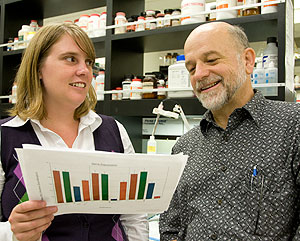2002 Karl Meyer Award Winner
Diagnostic Expertise: Autopsy service Clinical Interest: Anatomic and Molecular Pathology - Autopsy Pathology Research: Unique carbohydrate structures have been described on an increasing number of secreted and membrane glycoproteins. Recognition of these structures by highly specific receptors has important biologic consequences. These carbohydrate specific receptors play roles in glycoprotein folding and assembly, inflammation, development, malignant transformation, and targeting. We have identified a new carbohydrate binding motif that mediates recognition of a unique family of carbohydrate structures terminating with the sequence SO4-4-GalNAcâ 1,4GlcNAcâ 1,4Maná (S4GGnM). This receptor has a second, independent binding site for carbohydrates that terminate with mannose (Man). The Man/GalNAc-4-SO4-Receptor is present in a number of different cell types. Its expression is both developmentally and hormonally regulated in a cell specific manner. We are continuing to identify new secreted and membrane glycoproteins that bear oligosaccharides with terminal GalNAc-4-SO4 and are recognized by the Man/GalNAc-4-SO4-Receptor. The Man/GalNAc-4-SO4-Receptor is a multifunctional receptor that is an important model for understanding how unique oligosaccharide structures are utilized for complex biologic processes in vivo. It plays an important role in reproduction in vivo because it recognizes the sulfated carbohydrates on LH, thereby controlling the circulatory half-life of LH. It has different roles in other settings. The expression of function by receptors like the Man/GalNAc-4-SO4-Receptor requires that unique carbohydrate structures be synthesized on specific glycoproteins. The sulfated carbohydrates on LH are assembled by glycosyltransferases that are protein-specific. Expression of these transferases, like expression of the above receptor, is developmentally and hormonally regulated in a cell specific manner. We are determining at a molecular level how glycosyltransferase expression is regulated during development and during different phases of the hormonal cycle; how expression of the GalNAc-4-SO4-receptor is regulated; and how these structures play a role in recognition events which occur during inflammation and development. Since these carbohydrates and the Man/GalNAc-4-SO4-Receptor play important roles in multiple settings, we are preparing mutant mice deficient in receptor expression to establish the role of this system in vivo. Using these model systems we will define the multiple biologic roles played by this complex system. |


 Jacques Baenziger, MD, PhD
Jacques Baenziger, MD, PhD